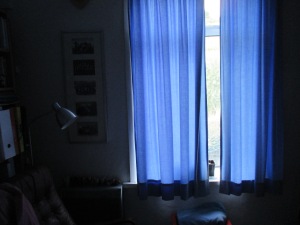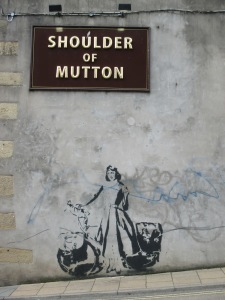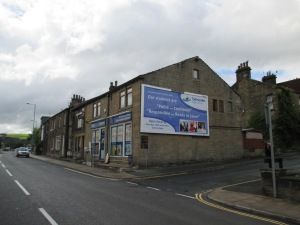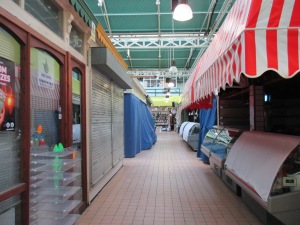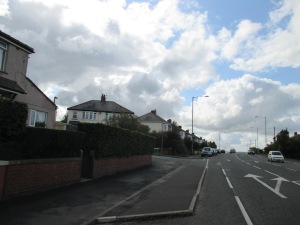‘Everybody’s called John at some point in their lives” – Towneley arms, Longridge.
By the law of averages alone, there ought to be at least one nice dry and sunny day in England. Just the odd one to balance out these rainy showers and moody clouds. A peek outside at the steep hills of Luddenden Foot suggests my number’s come up. Over porridge, Kirsty tells me about the histories and landscapes of this area where she’s lived for some twenty years after being priced out of her native Harrogate. There’s much here to explore in these former mill villages on the border of Lancashire and Yorkshire, in an area called Calderdale after the river that flows through it, and so together we venture out in her, off to explore.
At the ‘Foot’ is the Rochdale canal, where once two large mill buildings were situated. One made the velvet covers of bus seats and the like until it was recently demolished. The hills are airy, light, gentle, but at their time of operation this was a ‘dark and gloomy’ landscape. Such pretty properties like these were cheap for a reason, marked in soot, housing families of workers whose vision and hearing were progressively ground away by the nature of textile work.
Just up the road is Mytholmroyd. Head off the main road into a small neighbourhood of sooty terraced houses and one will find the small house where the poet Ted Hughes spent his first eight years. Again, the mills have largely been razed, and woods more recently planted here. There’s a quiet feel about the place, but it’s no deindustrialised desert. The clocks tick away at a slower pace.
The next village up is Hebden Bridge, home of a long-established community of artisans. The town hall has recently been bought collectively by the locals, and with funding they’ve built a theatre and spaces for local businesses at the back, a great model for cooperatives. By the rear garden area is a most unusual sandstone statue of a grieving woman, dedicated to the memories of the First World War. Local artisans plan to age this statue, carving its own kind of existence to mirror our human one. There’s an alternative technology centre by the canal. Some old mill buildings still remain, one used for various shops, there being tea-rooms and small cafes around, though not as many galleries as one would expect. It’s a little bohemian I suppose, but more for the moneyed traveller. One café sells organic fruit cakes for dogs. The only graffiti here is an elaborate stencil print of Sylvia Plath with a bicycle below the Shoulder of Mutton pub. There are tourists here, but it’s not as touristy, a nice contrast to the Lakes.
We drive up a steep hill to Heptonstall, looking largely unchanged since the mid-19th century, that same characteristic large brick terraced housing. Kirsty’s friend Norman owns ‘The Workshop’, which lives up to its name. There are hens and chicks in cages and all manner of old and disused tools, as well as some discarded medieval stocks nearby. Further up is a cloth hall from the mid 16th-century, and the ruins of the large St. Thomas a Becket church built in the 12th century and since expanded. Its pillars and window-arches are graceful, relieved of the burdens of the roof and stained glass. We sit here and enjoy the tranquillity of the place. Situated on a steep hill and showing little evidence of the arrival of the 20th century, Heptonstall feels far away in space and time from the rest of the world. I eat a Yorkshire curd pie, a sweet but bland tasting egg tart with currants, and trace the passage of time in the weathering of the stones.
Nearby its modern mid 19th-century replacement stands, and in a cemetery, the grave of Sylvia Plath. ‘Even amidst fierce flames the golden lotus can be planted’ reads the epitaph, a line picked from the Hindu scriptural text the Bhagavad Gota. There is a small group of retired men and women standing nearby, a local reading group who’ve been reading Plath’s The Bell Jar. We agree she was a tortured writer, ‘difficult’ to read, yet they’ve taken something from it, an immersion or gauntlet perhaps in the darker corners of oneself where ambivalence, despair and guilt are swept away, festering, near-forgotten. The man I speak to points that Ted Hughes mustnt’ve been a good husband for her suicide to have taken place. So much unhappiness was known in and around their lives, during and since, I cannot bring myself to comment on it, but culpability is a mean and misplaced issue I think.
Heptonstall’s well worth the time we take exploring it. Afterwards we head back through Oldtown where asbestos was once manufactured. Many local workers have since become very ill. Midgely follows, with a beautiful heather moor at the back, the smell distinct and clear, sweet like its taste in honeys. We sit out among the heather and look at the view of the valley, which is just wonderful.
Early afternoon has wound around, and it’s time to part ways. I am now heading back westwards, leaving the mills and the dales, on the road towards Liverpool and Wales. I follow the Rochdale canal towards Mytholmroyd by bicycle, but the track is too rough and narrow to dare venturing further. I reach Hebden Bridge next, where I stop in the Fox and Goose pub. It’s an unremarkable boozer on the edge of the village, but it’s the first cooperatively-owned pub in West Yorkshire. It took a two year campaign of locals to secure the £130k needed to buy and refurbish the pub. Around 260 people have stakes in the place, and the bar has around five staff and six steering directors, as well as drawing on local voluntary support with paintwork and the like. The service inside is informed and friendly, and the beers not bad either. Mine’s a Bridestone’s Goose Juice, tasty stuff. The pub serves no lager or food and is minimally appointed, raising two fingers up to the modern world. I like the place.
The road broadens out on its westward way to Todmorden, or ‘Tod’ to the locals, a small town that stands in more obvious decline than its more twee neighbours. Several old industrial buildings and mills along the way are closed up and derelict with no obvious plans for their reuse. But local people have been led by one community campaign that’s growing vegetables and creating gardens in vacant spaces across the town. It’s called Incredible Edible, a group that’s existed for around ten years. Their work has been tremendously successful. Other groups have sprouted up in other parts of the UK, attracted to the concepts of urban gardening with a clear communal focus. The herbs can be freely picked and eaten here. I’m told in the town that visitors from across Europe have also visited the place.
It’s a promising campaign, I think. The planters in the streets are thriving with herbs and plants pleasing to the eye. Because of its communal involvement and ethos, it raises a challenge to the NIMBYism that characterises much of the garden fence disputes of the wealthier south of England. ‘At first, we had trouble getting people to help themselves … because we’re from a country where people say, ‘Get off my land’, so we had to tell people it was OK’. Now the campaign is involving local people and businesses, and was recently visited by the green-fingered Prince Charles. I’ve been involved in a community gardening project on my estate in Oval, and I’ve learned much about growing, planting, as well as getting to know new people in my area. I wish this scheme well.
After Todmorden I start to recross places I passed days earlier. I head through Habergham Eaves but cycling round Burnley rather than pass through it, a place I am glad to avoid. Instead I go through Padiham, a small and slightly shabby town, then head out along to Whalley, and from there along the Lancashire Cycleway, pleasant country roads that pass Old Langho, Dinckley, Ribchester and eventually Longridge. The skies are wonderful, rich and gold lining these grey clouds, the occasional shower today but in all just nice. I remember Andy in Blackpool telling me about this part of Lancashire. He went to Norfolk one time time but hated it. ‘There were no hills, I could see everything all around me. It was just boring.’ There’s a masochistic pleasure in scaling hills for some, but it’s the variety and occasional drama of these picturesque vistas that I love the most.
Longridge is a small and quiet town, and doesn’t seem to have much to it that predates the 19th century. I venture in and stock up in the local supermarket, where the cashier and I discuss the nightclubs of Preston. I’m given tips by her and other young people in the queue about pubs to pass the time in here, all with a slightly wry smile suggestive of my looming disappointment. I make a mental note to try the nearby Towneley, though the Forresters they say is good. Well…
Outside an old feller, immaculately dressed, grabs me in conversation. ‘Big bags you’ve got!’ He congratulates me on the great distance I have apparently travelled, nearly three months since I started. He warns me not to camp due to the worsening weather here. Cold is becoming familiar, as is that damned rain and wind, and I can feel the autumn in my chilled bones. The final leg of this journey will be more difficult than the beginning.
I sit in the Towneley pub supping on a pint of local ale whose name or character escapes me. For the sake of how fundamentally generic most of these English ales are, let’s call it for argument’s sake ‘Olde Toby’ or ‘The Pendle Woofer’ and that it tastes mildly hoppy, nutty, or biscuit, but let’s be honest: warm, flat, sweet, like most others. Burnley’s football team have recently been promoted, and locals demand the TV be switched on to watch their first match against Chelsea, the local side being unfortunately demolished by the wealthier side. But why am I drinking in Longridge?
My friend Steve is from this town, though ordinarily he lives in a southern suburb of London. But he’s up to spend time with his family, and my passage through these parts is well-timed. I meet him outside his parent’s home, a large and grand Victorian affair in Longridge’s one pretty corner by St. Lawrence’s church. We put the bicycle away in a hut by an outdoor swimming pool, and talk over cups of tea in the well-appointed kitchen.
Steve had worked as a university lecturer after completing his PhD for a time, but found the fads and nature of academic work uninteresting. He enjoyed his research but disliked the pretentious fog of theory that had to be necessarily packaged around any kind of series of original ideas or research observations. So he moved into working as a teaching assistant in a secondary school, a job that’s in many ways more difficult and unfairly low-paid, but far more rewarding and engaging for him.
Teaching assistants work with children with often very challenging behavioural problems or learning needs. They make their education possible. They work with young people who have had difficult upbringings, or have been marginalised by mainstream forms of education, and in helping them learn, provide them with confidence and skills to hopefully become independent adults. It may not always work out that way, but their’s is a vital role. And yet their numbers have been steadily cut down in recent years. Change in student payments mean that under a false rubric of ‘choice’, parents could ‘choose’ to spend their allocated support money for improvements to their home (perhaps originally covered by benefit payments, or charitable grant giving organisations that’ve now gone bust) instead of learning. Difficulties lie ahead. The incompetent and unpopular Education Secretary Michael Gove, fortunately since removed from his role, had recently mooted getting rid of teaching assistants altogether.
‘That you can have a health secretary who is not a doctor, or any cabinet minister who doesn’t have any experience of these areas, is incredible. These people have been in politics since leaving university. Most of the current cabinet were previously, at a time, special advisors. They haven’t done a day’s honest work in their lives.’
We move onto politics, and a recent family barbecue has resulted in a fridge stuffed with leftover beers. Steve raises an important concern that relates to my project.
‘You can’t just diagnose the sickness, you’ve got to have a remedy.’ So what about forms of learning at the moment? ‘It’d never happen, but I’d have groups of four or five, small classes. These modern classes of 30 are just too much.’ Having observed them first hand for several years, Steve feels that teachers have become too trapped in having to adhere to a curriculum and standardised teaching. This has become increasingly obvious in the last year or so. The input of teachers has been whittled down, deskilling the profession, making it an exercise in passing exams, a memory test that reduces teaching and learning to a robotic process.
The best teachers he observes are actually more old-fashioned, ‘chalk and talk’. The fads for Powerpoint presentations and interactive moments can cause a sensory overload that is difficult for young people with attention problems and autism to follow. Though like me, Steve’s a natural libertarian and dislikes authoritarianism in the classroom, a firm disciplinary control actually makes it easier for the students he works with to learn. A certain amount of structure and order is needed so that young people can engaged and confident in what they’re learning. ‘The students we have more difficulty with are those whose parents treat them like a younger friend’.
We share our concerns about the present. Steve at first raises a somewhat humorous anecdote about how his relatives have become far more alarmed about the dangers to their children, something which has now started to influence older relatives in the family. ‘They don’t think it’s safe’, but this is a whole level of fear missing from when Steve and his sister grew up. This is probably one of the most safe eras in modern British society to be a child, and yet each day newspapers generate great revenues in alarming readers with tales of online and real-world menaces, be it pornography, predatory paedophiles or who knows what else. Children are becoming socialised in a far greater climate of fear.
It reminds me of a story Kirsty had told me that morning about her grandfather. As a child he would spend weeks walking around Snowdonia during summer holidays with ten and six. He would roam around the fields and sleep either there, or take refuge in church doorways. He absolutely loved it. Today children are more likely to have tablets and smartphones, and are socialised by their parents’ anxieties to – I would expect – become even more anxious, cowed and intimated from a younger age, to an even worse degree. I think of the fields I’ve passed today. The children are grown like cattle, given plenty to feed their bellies and attentions and kept by fear in one place, this social field. ‘It’s scary the way schools are going now. They’re like massive farms to churn out office workers.’
All we fear is fear itself, sang Aaron Neville once. ‘Did you see in the Mail that ninety percent of people are afraid of terrorism?’, Steve raises. The nature of the survey could be disputed easily, but this problem of fear is more worrying. Terrorism was a more present and genuinely real threat during the bombing campaigns of various dissident Irish republican terrorist groups from the Seventies to the mid-Nineties, but recent news coverage of conflicts in the Middle East has had many of my interlocutors worrying about the dangers of jihadi terrorists. For all the global news our phones and computers summon up, I can’t help feeling that the popular conception of the dangers of the world is so far removed from the opportunities within it. Presented here is a stage-set of fear and anxiety. Afraid, one seeks the protection of authority and the preservation of traditions. Dreams of political and social transformation are put aside for another time. In this way protest, dissent, and the collective demands for democratic representation are stifled. Perhaps checking the news isn’t such a healthy pastime.
It’s getting late, and I have a large and very comfortable room in the loft of the house. After hours of conversations about our lives and the ways of this woebegone world, we tire, and yawn, and catch some sleep.
